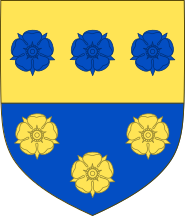
Back Лоредан Bulgarian Loredan BS Loredan (Adelsgeschlecht) German Famille Loredan French Loredan Croatian Loredan Italian 로레단가 Korean Loredan Romanian Loredan Serbo-Croatian Loredan Slovenian
The House of Loredan (Italian: [lore'dan], Venetian: [loɾeˈdaŋ]) is a Venetian noble family of supposed ancient Roman origin, which has played a significant role in shaping the history of the Mediterranean world. A political dynasty, the family has throughout the centuries produced a number of famous personalities: doges, statesmen, magnates, financiers, diplomats, procurators, military commanders, naval captains, church dignitaries, and writers.
In the centuries following the fall of the Western Roman Empire, the Loredans were lords in Emilia-Romagna, from where they came to Venice in the early 11th century. Settling there, the family grew in power in the High Middle Ages, amassing great wealth on the lucrative silk and spice trade, and in the following centuries it became powerful and influential in regions across the Mediterranean, playing a significant role in shaping its history throughout the Late Middle Ages, the Renaissance and the early modern period. The family was present in virtually every home and overseas territory of the Republic of Venice, and at various points in history, its members have held titles in what are now modern countries of Italy, Austria, Slovenia, Croatia, Montenegro, Albania, France, Greece and Cyprus, and conducted trade operations as far as Egypt, Persia, India and China. Alongside other families of Venice's urban nobility, they played a major role in fostering mercantilism and early capitalism.
Although the Loredans were proponents of Venice's traditional, maritime orientation, and viewed with distrust its expansion on the Italian mainland, they played a key role in the territorial development, and ultimately, the history of the Republic of Venice, helping to expand its Mainland Dominions and the State of the Sea. The family was significant in the War of the League of Cambrai, with Doge Leonardo Loredan leading Venice to a victory against the Papal States, which resulted in the pope having to pay the Loredan family a financial settlement of approximately 500,000 ducats, an enormous amount of money, making them one of the richest families in the world at the time. Furthermore, many of its members distinguished themselves as admirals and generals in defending Europe from the Ottoman conquests in the Ottoman-Venetian wars. Their various naval triumphs have been honoured with the MV Loredan auxiliary cruiser of the Italian Royal Navy.
The family has also played an important role in the creation of modern opera with the Accademia degli Incogniti, also called the Loredanian Academy, and has commissioned many works of art by artists of the Venetian School, including Giovanni and Gentile Bellini, Giorgione, Vittore Carpaccio, Vincenzo Catena, Sebastiano del Piombo, Titian, Paris Bordone, Jacopo and Domenico Tintoretto, Paolo Veronese, Palma il Giovane, Canaletto, Pietro Longhi and Francesco Guardi, among others. At the height of the Renaissance, the family's residences were being designed and constructed by renowned architects, notably Mauro Codussi, Jacopo Sansovino, and Andrea Palladio.
The wealth of the Loredan family in Venice was legendary, likely reaching its height in the 18th century, when they owned numerous palaces, as well as hundreds of estates and vast land holdings across the territories of the Republic, primarily in the Veneto, Friuli, Istria and Dalmatia. Besides the silk and spice trade, they also participated in the medieval slave trade, and were, more than once, accused of usury and sodomy, often by long-time political rivals such as the Faliero and Foscari families. In cases of corruption, assault, murder and other scandals, when members of their own family were involved, the Loredans usually pursued a policy of lenience and outright tolerance, and aimed to resolve relating accusations by means of threats or bribery.
Under a Loredan government, the first Jewish ghetto in the world was created in Venice in 1516, although some members of the family argued in the Senate for the reduction of the sum the Jews had to pay for their "conduct". In the 17th century onwards, the Loredans were noted for supporting and taking in Jews arriving in Venice, several of whom adopted the 'Loredan' name in recognition of the family's generosity.
Today, the Loredan coat of arms, which features six laurel (or rose) flowers on a shield of yellow and blue, is displayed on numerous buildings and palaces across the territories previously held by the Republic of Venice; from the Veneto and Friuli, Istria and Dalmatia, and in the more distant possessions such as the Ionian Islands and Crete. In Venice, it is even carved into the Rialto Bridge and the façade of St. Mark's Basilica.
